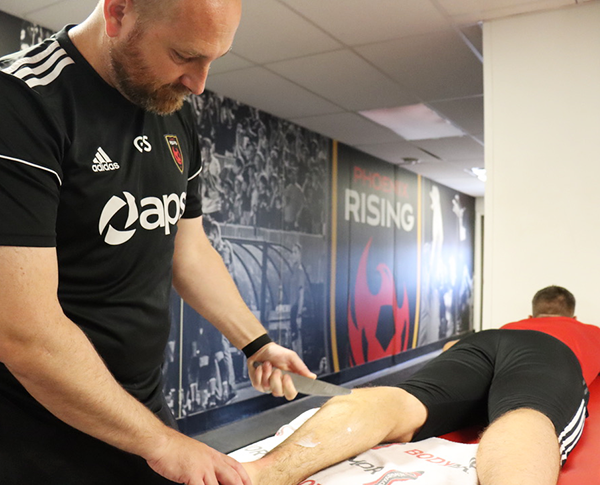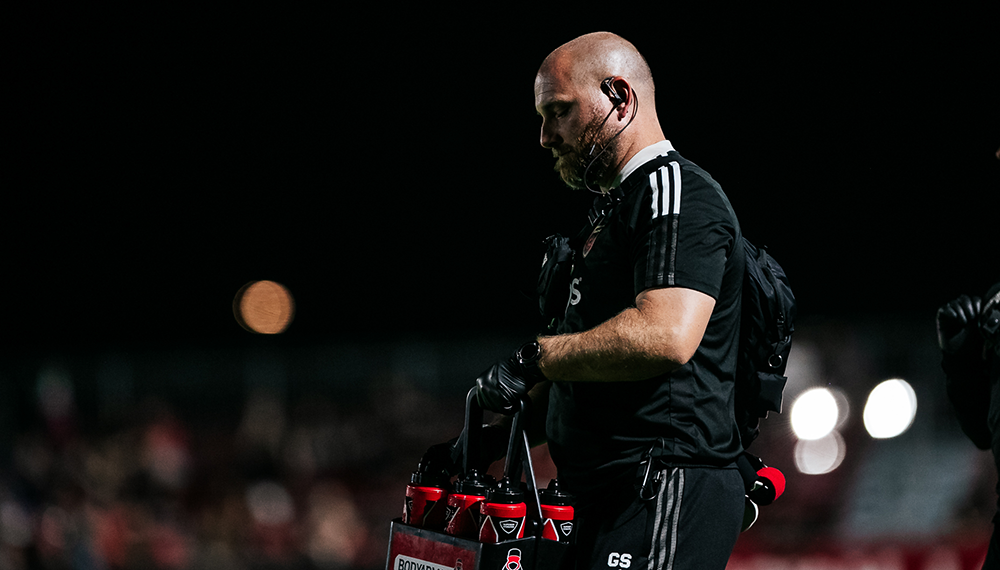The role an athletic trainer plays within a professional sports organization can vary from team to team, but one thing never changes: providing the best care for the athletes they treat and work with daily. Spooner’s Athletic Trainer, Greg Spence, MA, ATC, provides us with a glimpse into his role in helping Phoenix Rising athletes return to play.
As the team goes through final warm-up, I’m off to the side dutifully holding water amongst other items needed for preparation: smelling salts, Vick’s, an inhaler for that one guy. This is a game like any other, but also there is something different because we have a player re-joining the starting eleven after injury. Whether the road was long or short, straight or jagged, this game has just a little more weight to it. Weight because I’ve been there since the beginning. I saw the initial devastation after the athlete was injured and knew they would spend some time away from the game they love. I looked at the circumstance of the injury, evaluated the individual, reached a diagnosis, gave direction, collaborated with the sports medicine team, and treated his condition. More importantly, we worked to determine why it happened because the why is always the crucial part if we hope to avoid repeat injury.
After all that, we both arrive at today, and he’s ready to play. As I wait for the official to blow his whistle, I might run through some of the questions that needed to be answered in the affirmative to get him to this point. Is his strength back to normal? How about his range of motion? Has he gone through enough training? Has he reached his top speed? Have all symptoms resolved? Is he confident in his ability to return to play? I hate that I do this to myself, run through all those questions again as he is about to take the field, but everyone has nerves on game day, right?

Then, I remember the coordinated effort over the past few days, weeks, and possibly months. First and foremost, the player, in his moment of physical malady, must steel his mental resolve for the journey ahead. It’s one that he won’t go alone, but no one can do it for him. Then the coaching staff, whose support is invaluable. They understand that their athlete is feeling less than whole and will encourage and challenge them. Lastly, the slew of medical professionals who must meticulously plan the direction the process will take. The timeline will be set and, as the athletic trainer, I must organize the thoughts of the physicians, physical therapists, and strength and performance coaches who all have valid opinions, rooted in evidence and past experience. We must work together in coordinated care that puts the athlete at the center. This athlete has put his trust in us, and he deserves nothing less than the best of what each of us has to offer.
The rehabilitation plan will go as planned sometimes, and, sometimes, it will need to be a more dynamic, fluid process. But always, myself and the team behind the plan will create a program unique to each athlete. Ultimately, progress and return to play are never reached without the confidence of all those involved. So, as I step back on the sideline, and the game reaches a start, I relax a little bit. I watch the game play out, and the athlete has done well. Maybe he scored or had an assist; maybe he didn’t. For me, that doesn’t matter. The win comes from him finding himself.
If you are an athlete and have been recently injured, we want to help you get back to your sport at your best and as soon as possible. Schedule an appointment with a Spooner therapist today to get back on the field again.

